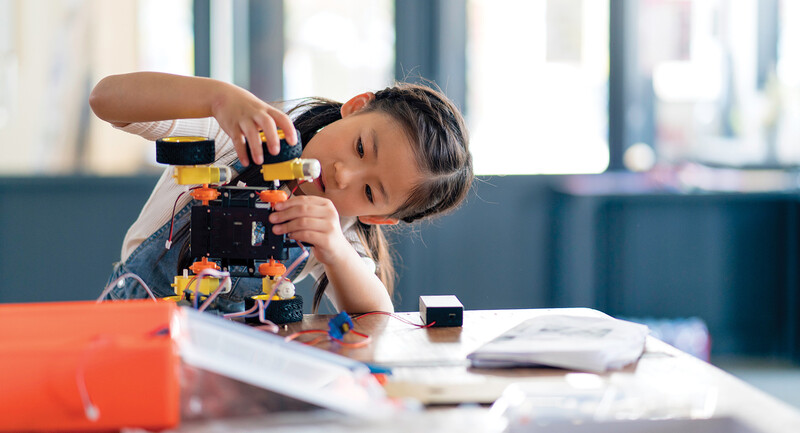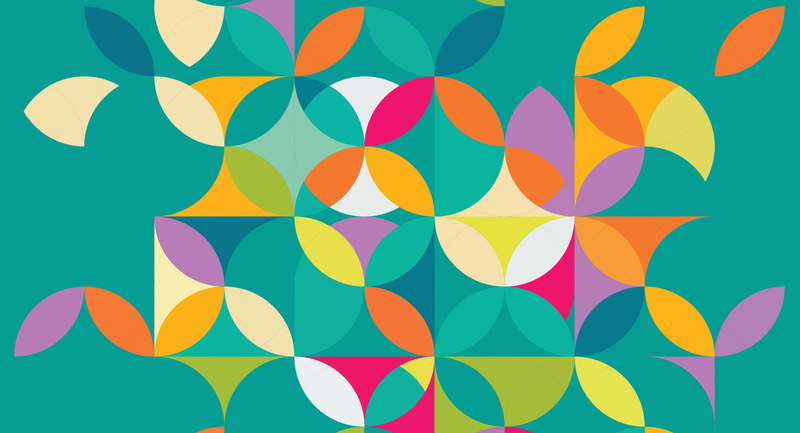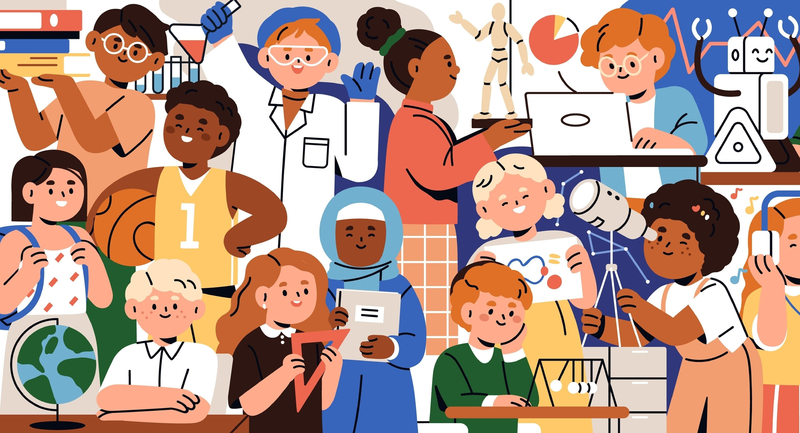Ms. Amato's 5th grade mathematics classroom buzzed with curiosity and anticipation. Marbles slid over malleable plastic tracks, clinking into one another, falling on the floor, and creating moments of laughter and active learning. Learners gathered closely around their stations, recording evidence; taking and analyzing measurements with their protractors, rulers, calculators, and graphing paper; and discussing their hypotheses.
The lesson, Ms. Amato had explained to her students minutes before, focused on measuring and predicting projectile motion. Workstations around the classroom provided the materials to develop questions and test hypotheses about what influences the motion of marbles.
The activity set learning in motion, both figuratively and literally. Students engaged with the project immediately, allowing Ms. Amato to spend her time in small-group and one-on-one conversations about projectile motion, encouraging her students' curiosity, and collecting meaningful evidence of learning that would guide the next day's learner-driven experience.
John, a coauthor of this article, observed Ms. Amato's class that day. It was clear that this type of instruction began with Ms. Amato's foundational belief that students are capable of driving their own learning. She knew that they had the tools to overcome challenges and recognized that their background experiences—what psychologist Jean Piaget refers to as students' "schema"—could fuel their curiosity, discourse, and the co-construction of knowledge. Our experiences as educators have shown us that for students to drive their own learning, they must: (1) believe they are capable of doing so; (2) have the autonomy to make decisions during the learning journey; and (3) notice the relevant actions, words, tasks, and tools within the classroom that support learning. This third factor is perhaps the most undervalued component of self-directed learning. By teaching students how to notice, we support them in gathering the essential information they need to make decisions about where to go next in their learning.
What is Noticing?
Noticing is the active process of attending to what is happening during a learning experience (Schoenfeld, 2011). Teachers and students must notice happenings that are relevant to their work toward the learning intention. This can include details in learning tasks that pique interest or create cognitive dissonance, as well as social interactions, physical sensations, or emotions. Both teachers and students participate in noticing within a complex classroom environment. What we notice as teachers informs our next moves in our instruction; what learners notice guides their next moves in their learning journey (Sherin, Jacobs, & Philipp, 2011).
Ms. Amato's noticing requires her to recognize learners' actions and words during their scientific inquiry—for example, in their use of scientific language, manipulation of the variables, and use of evidence to make inferences or draw conclusions. She must then interpret those actions through the lens of where her learners are headed (that is, the expected learning outcomes for the day). If learners are not clear on specific scientific phenomena or are misapplying vocabulary and ideas, she can provide feedback to help them continue to move forward in their learning.
Ms. Amato's students, in turn, must notice what is happening during their inquiry into projectile motion, in their interactions with peers, and within themselves as sentient learners. They might notice when their peers are manipulating two variables at the same time and offer critical feedback for their group. They may also notice when one of their peers has identified a key relationship in projectile motion and ask them to explain their finding to the group.
For both Ms. Amato and her learners, noticing is grounded within the day's success criteria, which is often communicated through a rubric or co-constructed set of expectations. Students' awareness of the success criteria is supported by an intentionally designed culture of self-directed learning, complete with co-constructed classroom agreements and regular lessons around social-emotional learning and executive functioning. Noticing doesn't happen by chance: We must be deliberate in how we cultivate it within learners and ourselves by utilizing a process called engineering.
The prerequisites for engineering a culture of noticing are two-fold: (1) teachers must choose strategies that consistently offer students opportunities to show what they have learned and (2) teachers must provide students specific tools that scaffold noticing as a behavior.
Strategies for Evidence Generation
In order to notice, there must be something tangible to observe. This requires that we make learning visible to both our learners and ourselves through consistent evidence generation. Strategies that generate evidence require learners to actively select, organize, and integrate thoughts, feelings, observations, and other data into the learning experience (Fiorella & Mayer, 2015; 2016). This evidence allows teachers ample opportunities to engage students in noticing. The four foundational strategies for generating this kind of evidence are: summarizing, imagery, mapping, and elaborative interrogation.
What we notice as teachers informs our next moves in teaching; what learners notice guides their next moves in their learning journey.
Summarizing
Learning is more visible to teachers and learners if they can construct a summary of their learning verbally, in writing, or by using idea-sharing apps such as Flipgrid or Loom. Summaries provide visible evidence about what students have noticed, and they allow learners to select vocabulary, organize their thinking, communicate with teachers and their peers, and even reflect on emotional reactions or responses to content. We recommend three-minute writing assignments using prompts such as, I used to think … Now I think …, or the Circle-Triangle-Square strategy. These tools offer students the opportunity to summarize where they are in their learning process at strategic points within the lesson, most commonly at its conclusion.
Mapping
Arranging ideas and thoughts with a thinking or concept map allows students to show how they are linking, grouping, or organizing what they've noticed in their learning. Learners can also use thinking or concept maps to organize their thoughts around essential knowledge, skills, and understandings (Hyerle, 1995). Examples of mapping include T-charts, Venn diagrams, Double-bubbles, or open-ended concept mapping. Focusing on how these tools empower learners to group concepts and organize their thoughts allows them to draw deep connections that support the transfer of learning.
Imagery
There is a large body of research on the importance of imagery in learning. Whether teachers use an image to invoke classroom dialogue (e.g., providing a historical picture, such as a Dorothea Lange photograph, and asking learners to describe the context of the photo) or students create images to reflect their thinking (e.g., asking learners to design a visual representation of different mathematical processes, such as various ways to multiply multi-digit numbers or modeling data), imagery makes learning visible. Having a clear picture of how students are learning provides teachers insight into what students notice and how they respond to what they notice.
Elaborative Interrogation
An evidence-generating classroom always encourages teachers and learners to ask follow-up questions. When learners assert a hypothesis, make an inference, or draw a conclusion, teachers and peers should ask them to elaborate on their thinking and feelings. Interrogative responses like, "What makes you say that?", "Tell me more about what you are thinking," or "Have you considered a different perspective?" require learners to revisit their original response and make their internal decision making visible to us, their peers, and themselves. In the process, they reveal what they have been noticing.
Scaffolding Noticing
In order to engineer a culture of noticing, we must see noticing as a skill. The teacher's role in scaffolding noticing is critical: we must support students in using tools to build their independence by modeling and providing feedback on their noticing skills. By doing this, we can help learners take ownership of what they notice and operate with greater independence.
Scaffolding noticing contributes to an ever-evolving mindful classroom culture. The word mindfulness literally means "full of mind," an idea that expands beyond meditation to encompass emotional, physical, cognitive, and social awareness, each of which supports learners in self-direction so they can make informed decisions about their learning. These types of awareness are interconnected; an emotional experience can elicit physical sensations within learners just as a physical, social, or cognitive experience can bring up strong emotions in learners. Building learners' awareness helps them notice sensations within themselves, others, and their surroundings that they may not have been able to identify before.
This noticing also allows us to build students' executive functioning skills, such as cognitive flexibility; mental, emotional and physical self-regulation; and working memory function. The following strategies can scaffold noticing to build self-direction:
Build a culture of self-reflection.
After generating evidence of student learning, we then need to provide opportunities for learners to reflect. Reflecting on learning enhances awareness and helps learners connect their efforts to tangible indicators of progress and mastery (Pink, 2011). Building a sense of mastery leads to increased intrinsic motivation in students by helping them see that they have influence over their progress in the classroom. At the end of lessons, gather learners together and ask them to identify times when they succeeded, moments when they struggled, and ideas for the next steps in their learning. Doing this daily builds a culture of goal setting (France, 2022) and self-reflection that can soon be internalized and leveraged for self-direction.
Self-reflection should be grounded in tangible goals. These can be social, emotional, or metacognitive in nature, but they can also be related to academic standards within the curriculum. Leveraging learner-friendly rubrics to prompt self-reflection, such as the Unit 1 Math Assessment rubric (see Figure 1), can provide accessible language for self-reflection.
After students self-assess using a rubric, they may need help in furthering their reflecting. Instead of broad, relatively meaningless reflections like the statements in the left-hand column of Figure 2, consider providing language that supports mindset shifts, specific action steps, or questions that provoke deeper curiosity about learning artifacts (as suggested in the right-hand column).
Leverage tools and vocabulary for building executive functioning.
If we don't provide learner-friendly vocabulary related to executive functioning, students will not be able to effectively reflect on their learning habits or executive functioning skills. In order for learners to be self-directed, they must notice the ways in which their learning habits and executive functioning skills are impacting their ability to make choices in the classroom. These skills include emotional, physical, and metacognitive competency.
To build emotional competency, use an emotional intelligence framework to generate a list of emotion words, such as RULER's Mood Meter (Yale Center for Emotional Intelligence, 2022) or Leah Kuypers' Zones of Regulation (2011). Teachers can ask students to identify colors associated with their emotions or to identify specific emotions that are noted within the frameworks. In addition, provide sentence frames, such as:
You can use similar vocabulary for physical regulation. Once students notice and communicate a physical need, they will also need explicit instruction and modeling on how to use sensory regulation tools such as bouncy balls or fidget tools.
For reflection on metacognition or cognitive flexibility, consider using the sentence frames below. You may want to combine these with the meaningful reflections from Figure 2.
Allow for quiet moments.
Teachers have the capacity to unknowingly inhibit student self-direction if we're not mindful about how frequently and for how long we intervene. Too much intervention can limit a learner's capacity to process information independently, come to a decision, or form a complete thought.
But there is a simple solution to finding balance in this dynamic: notice learners' actions and body language and wait for them to respond. Thinking looks different for every learner. Students may stare at the ceiling, or squint their eyes, or mouth the words that are running through their minds. If at any point you are wondering whether to intervene, simply ask "Are you stuck? Or are you thinking?"
Setting Learning in Motion
When learners are empowered to make decisions in the classroom—like the students in Ms. Amato's classroom were—they set learning in motion and take a bigger role in personalizing their experiences through choice. However, we can't expect learners to become productive partners in directing our classrooms if we do not intentionally engineer our classrooms for noticing first. This starts with collectively agreeing on a definition of noticing and is then fortified by practices that continuously generate evidence of learning in our classroom, so teachers can scaffold noticing as an essential skill and help students develop a deeper knowledge of themselves. Together, teachers and students can grow a learning environment in which all students internalize their classroom learning experiences.
Reflect & Discuss
➛ Why do the authors see "noticing" as such a key part of self-directed learning? Do you agree?
➛ What is one strategy you could use to gather evidence of your students' thoughts and feelings about their learning experiences?
➛ What steps could you take to better support and encourage noticing in your own classroom?









